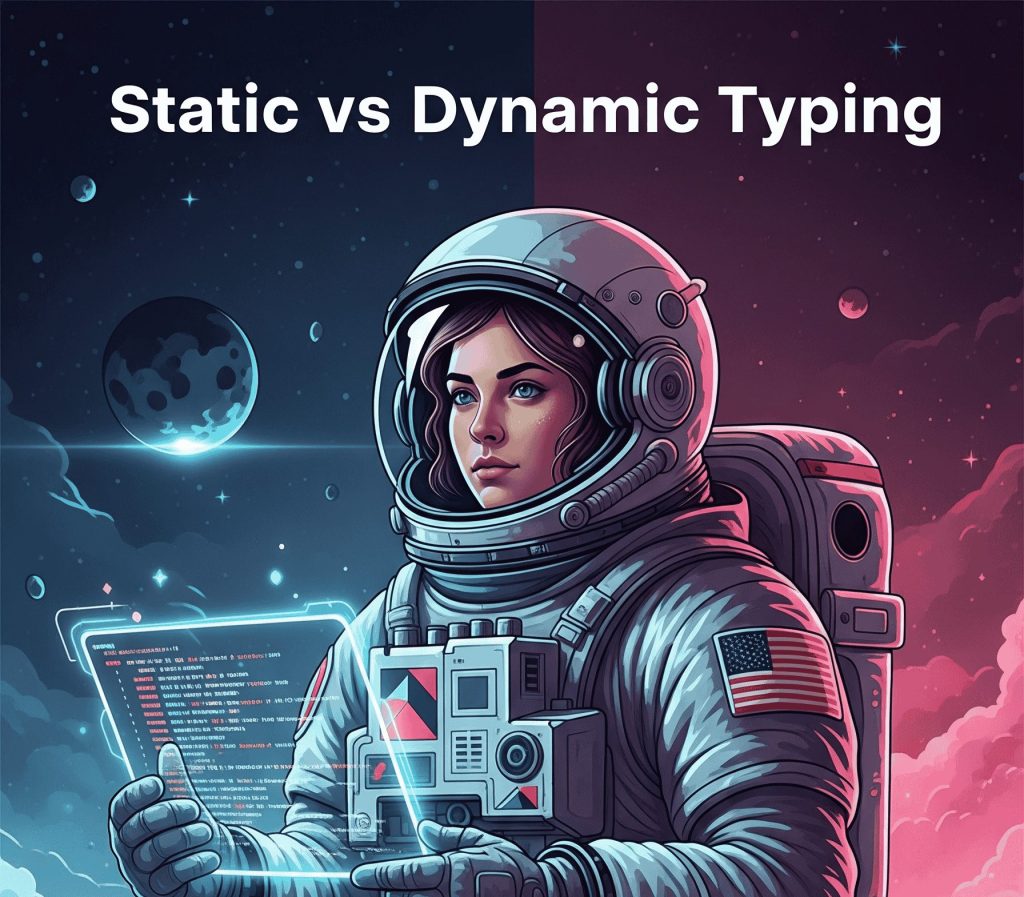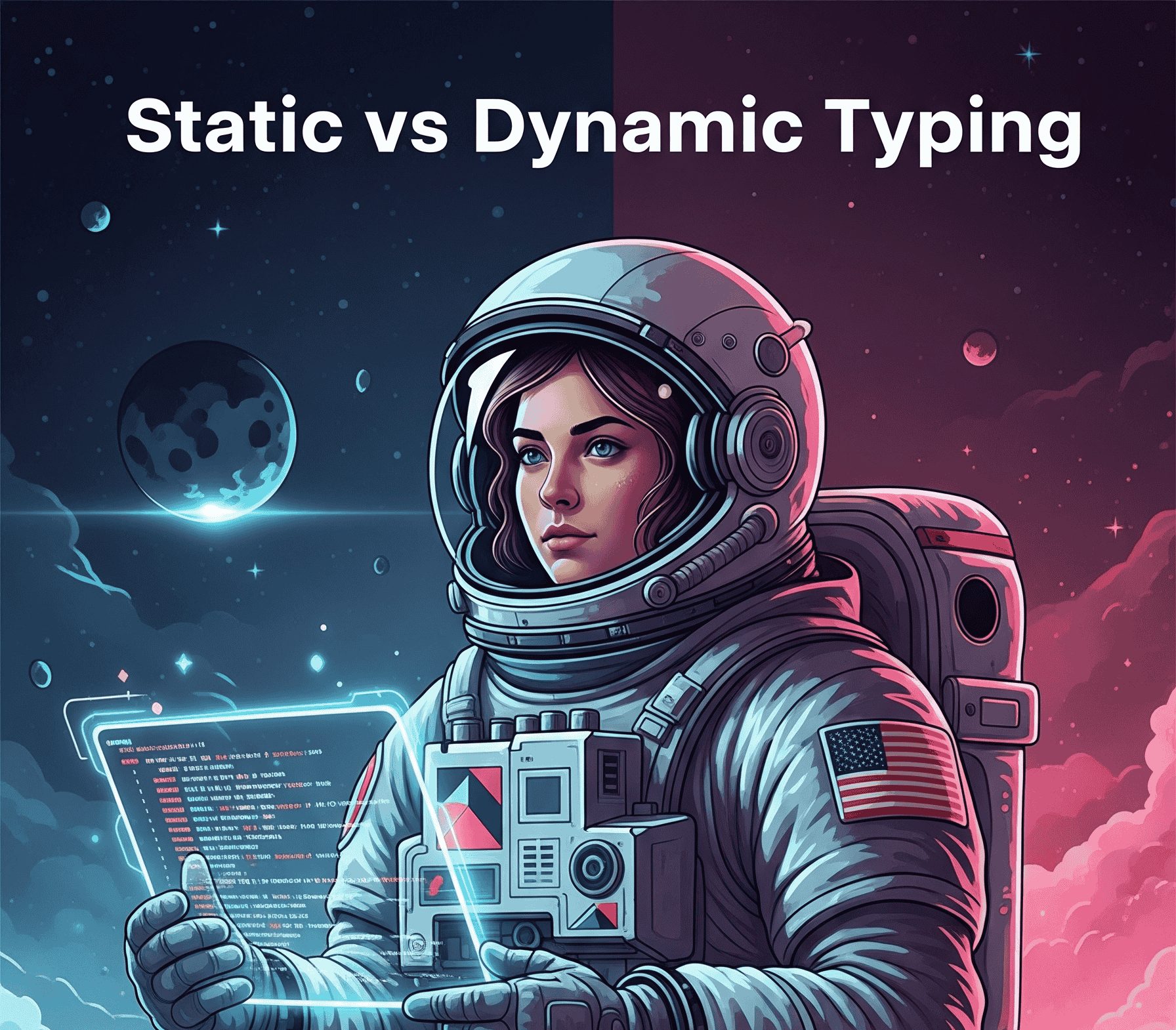
Have you thought about how programming languages handle different kinds of data types like numbers, text, or Boolean values? Concepts of static typing and also of dynamic typing come in. How any language works relies on each of them because they impact code maintenance also impact writing greatly.
Because it builds on JavaScript while offering optional static typing, TypeScript is known as a popular language giving to you the best of those worlds. Let’s dive in and understand what these terms mean and why they matter.
What is Static Typing?
Imagine you’re packing a box, and you labeling it clearly: “Only books allowed.” If you try to put a shoe in it, you’ll immediately know it’s the wrong type of item. That is essentially what static typing is all about.
Think of it like this:
- You tell the computer upfront: “This variable,
userName, will always hold text (string)” - The computer checks: When you try to assign a number to
userNamelater, it says, “Hold on! You said this was text, not a number, than why you are assigning it to number now.”
// Example: Statically Typed Variable in TypeScript
let age: number = 30; // We have declared 'age' as a 'number'
// This will cause an error during compilation (before running!)
// age = "thirty"; // TypeScript will complain: Type 'string' is not assignable to type 'number'.The Upsides of Static Typing
- Catch Errors Early: This is a huge one! Static typing helps you find many common mistakes (like trying to add text or string to a number) before your users ever see your code. It’s like having a built-in spell checker for your data types.
- Improved Code Quality: By catching errors earlier, your final code tends to have fewer bugs related to data types.
- Smarter Tools: Because the language knows the types, your code editors (like VS Code) become much more intelligent. They can offer better auto-completion, instantly highlight errors as you type, and make refactoring (reorganizing your code) much safer.
- Easier Collaboration: When working in a team, type declarations act like clear instructions, making it easier for others to understand what kind of data your functions expect and return. This is especially helpful in large projects where multiple developer are working on that project at a time.
- Potential for Faster Code: Sometimes, knowing the types ahead of time can allow the compiler to make your code run a bit faster, as it doesn’t need to figure out types on the fly.
The Downsides of Static Typing
- Can Be More Verbose: Declaring all your types might require you to write a bit more code, which can feel a little “boilerplate-y” at times to you.
- Steeper Learning Curve: For newcomers, understanding type systems can take some time to grasp.
- Complex Error Messages: Sometimes, the error messages from the compiler can be a bit cryptic, especially in complex scenarios.
- Less Flexibility (Sometimes): In certain niche situations, strictly enforcing types can feel restrictive if you genuinely need a variable to hold wildly different kinds of data at different times.
What is Dynamic Typing?
Now, let’s go back to our box analogy. With dynamic typing, it’s like having a box without any labels. You can put a book in it, then take the book out and put a shoe in, and then maybe a hat. The box doesn’t care what you put inside; it just holds whatever you give it, it is just opposite to the Static Typing, full.
In a dynamically typed language, the type of a variable is determined at runtime, meaning when your code is actually executing. You don’t explicitly declare the type of a variable. Instead, the language figures out the type based on the value you assign to it.
Think of it like this:
- You say: “Here’s a variable
myValue, and I’m putting the number 10 in it.” - The computer says: “Okay,
myValueis currently a number.” - Then you say: “Now I’m putting the text ‘Hello’ in
myValue.” - The computer says: “Alright,
myValueis now text.”
JavaScript, by default, is a dynamically typed language:
// Example: Dynamically Typed Variable in JavaScript
let data = 10; // 'data' is a number
console.log(data); // Output: 10
data = "Hello World"; // 'data' is now a string
console.log(data); // Output: Hello World
data = true; // 'data' is now a boolean
console.log(data); // Output: trueDid you notice how data can change its type without any errors during compilation. The error would only appear if you tried to perform an operation on data that wasn’t compatible with its current type (e.g., trying to add a number to the boolean true).
The Upsides of Dynamic Typing
- More Flexible: It’s easier to write code where a single variable can hold different types of data at different points in your program, it provide more flexibility as compared to Static Typing.
- Less Code to Write: You don’t have to bother with explicit type declarations, which can make your initial code look shorter.
- Quicker Prototyping: For small scripts or quick experiments, dynamic typing can allow you to get started faster.
- Natural for “Self-Describing” Data: When dealing with data structures like JSON (common in web development), where the data itself contains information about its structure, dynamic typing can feel more natural.
The Downsides of Dynamic Typing
- Errors Surface Later: The biggest drawback is that type-related errors often only appear when your code is actually running, potentially during production, which is much harder to fix.
- More Runtime Bugs: This “later detection” means there’s a higher chance of encountering type-related bugs in your deployed application.
- Less Optimized Code (Sometimes): Without knowing types upfront, the language runtime might have to do more work to figure things out, which can sometimes lead to slightly less performant code.
- More Testing Required: Since type errors aren’t caught by a compiler, you often need to write more tests to ensure your code handles different data types correctly.
- Harder to Refactor: Changing the structure of your code can be riskier because there’s no compiler to tell you if you’ve broken type compatibility.
- Less Clear for Collaboration: Without type declarations, it can be harder for other developers (or even your future self!) to understand what kind of data a function expects or returns without digging into its implementation.
- You may find yourself using
console.log()quite frequently 🫣
Why TypeScript is an Optionally Statically Typed Language
TypeScript offers a brilliant compromise. It allows you to use static typing when you want it, giving you all the benefits we discussed, but it also lets you “opt-out” and use JavaScript’s default dynamic typing if needed.
The key to this flexibility is the any type in TypeScript. When you declare a variable with any, you are essentially telling TypeScript: “Hey, I know what I’m doing here; don’t check the type of this variable!”. Also if you not asign any type to any var than it by default consider that var as any type.
// Example: Using the 'any' type in TypeScript
let myFlexibleValue: any = 10; // myFlexibleValue is initially a number
console.log(myFlexibleValue); // Output: 10
myFlexibleValue = "Hello there!"; // Now myFlexibleValue is a string, no error!
console.log(myFlexibleValue); // Output: Hello there!
myFlexibleValue = { name: "Alice", age: 30 }; // And now it's an object!
console.log(myFlexibleValue); // Output: { name: 'Alice', age: 30 }While any provides flexibility, it’s generally recommended to use it sparingly. Overusing any defeats the purpose of TypeScript’s type-checking benefits. It’s best reserved for situations where you truly don’t know the type of data coming in, such as when dealing with data from external, unpredictable sources.
The Power of Static Typing in TypeScript
When you use static typing in TypeScript, you unlock several powerful advantages:
- Robust and Reliable Code (More Reliable Code:): You build code that’s less prone to errors because the compiler acts as a vigilant guardian, catching mistakes early, helping you catch errors before they cause problems.
- Enhanced Developer Experience: Code editors (IDEs) become your best friend, provide helpful suggestions and instant feedback as you code, making you more productive, faster and easier.
- Improved Maintainability: Your code becomes easier to understand and maintain, especially as projects grow and involve more developers working on it. Type declarations act like clear documentation.
- Reduced Debugging Time: By preventing a whole class of errors, you don’t have to spend as much time finding and fixing bugs.
Static vs. Dynamic Typing: A Quick Comparison

| Feature | Static Typing | Dynamic Typing |
|---|---|---|
| Type Checking | Done at compile time (before running) | Done at runtime (while code is executing) |
| Type Declaration | Mostly required (explicitly tell types) | Not required (types inferred from values) |
| Error Detection | Errors found earlier in development | Errors found later (during execution) |
| Code Performance | Can lead to more optimized code | Can be less optimized (more runtime checks) |
| Flexibility | Less flexible (types are fixed) | More flexible (types can change) |
Conclusion
Understanding the difference between static and dynamic typing is crucial for any developer. Dynamic typing allows for more flexibility and quicker development in the beginning, while static typing—like the kind TypeScript offers that leads to more reliable, maintainable, and often more performant code, especially for larger or more complex projects/applications.
Using TypeScript to define types can make your application stronger and more stable in the long run. Think about your current project needs—would static or dynamic typing work better for you right now?
Offical TypeScript doc
